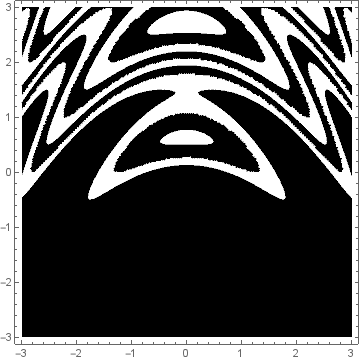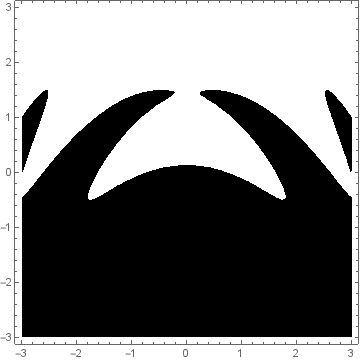Update: An alternative way to use ContourPlot using threshold as the single Contour with the option ContourShading:
threshold = .5;
ContourPlot[FractionalPart[y + Sin[x^2 + 3 y]], {x, -3, 3}, {y, -3, 3},
Contours -> {threshold}, ContourShading -> {Black, White},
Exclusions -> None, PlotPoints -> 90]

Similarly, DensityPlot with MeshFunctions, Mesh and MeshShading options:
DensityPlot[FractionalPart[y + Sin[x^2 + 3 y]], {x, -3, 3}, {y, -3, 3},
MeshFunctions -> {#3 &}, Mesh -> {{threshold}},
MeshShading -> {Black, White}, PlotPoints -> 90,
Exclusions -> None, WorkingPrecision -> 10]

And, a combination of Raster and Image:
Image @ Raster[Table[UnitStep[FractionalPart[y + Sin[x^2 + 3 y]] - threshold],
{y, -3, 3, 1/100}, {x, -3, 3, 1/100}]]

We get the same picture using Boole[FractionalPart[y + Sin[x^2 + 3 y]] >= threshold] instead of UnitStep[FractionalPart[y + Sin[x^2 + 3 y]] - threshold].
Original answer:
You can use ContourPlot with options Contours and ContourShading:
threshold = .5;
ContourPlot[y + Sin[x^2 + 3 y], {x, -3, 3}, {y, -3, 3},
Contours -> {threshold}, ContourShading -> {Black, White}]

Another alternative is to use RegionPlot:
RegionPlot[y + Sin[x^2 + 3 y] <= threshold, {x, -3, 3}, {y, -3, 3} ,
BoundaryStyle -> Black, PlotStyle -> Black, PlotPoints -> 100]

With DensityPlot you can do
DensityPlot[y + Sin[x^2 + 3 y] , {x, -3, 3}, {y, -3, 3},
ColorFunction -> (Black &), RegionFunction -> (#3 <= threshold &)]

You can also use DensityPlot with the option ColorFunction with large enough value for PlotPoints to get a similar picture the one above:
cf1 = If[# <= threshold, Black, White] &;
DensityPlot[y + Sin[x^2 + 3 y], {x, -3, 3}, {y, -3, 3},
ColorFunction -> cf1, PlotPoints -> 250]

Using cf2 = Blend[{Black, White}, UnitStep[# - threshold]] &; in place of cf1 gives the same result.










